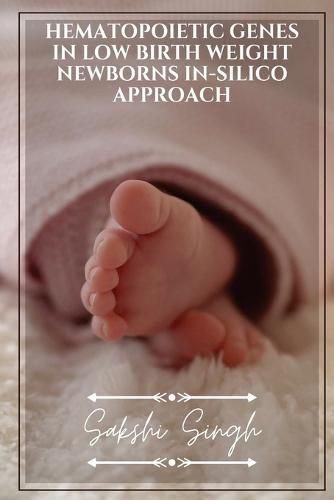Readings Newsletter
Become a Readings Member to make your shopping experience even easier.
Sign in or sign up for free!
You’re not far away from qualifying for FREE standard shipping within Australia
You’ve qualified for FREE standard shipping within Australia
The cart is loading…






This title is printed to order. This book may have been self-published. If so, we cannot guarantee the quality of the content. In the main most books will have gone through the editing process however some may not. We therefore suggest that you be aware of this before ordering this book. If in doubt check either the author or publisher’s details as we are unable to accept any returns unless they are faulty. Please contact us if you have any questions.
Hematopoietic genes play an important role in the development of blood cells and the immune system. Low birth weight (LBW) newborns are at an increased risk for various health problems, including hematological disorders. An in-silico approach is a computational method used to study and analyze biological data, such as genetic information. In the case of LBW newborns, an in-silico approach can be used to study the genetic factors that contribute to hematopoiesis and the development of hematological disorders. This can involve analyzing the genetic makeup of LBW newborns and comparing it to that of normal birth weight newborns to identify genetic variations or mutations that may be associated with LBW and hematological disorders. This can also include bioinformatics tools for functional annotation of identified genetic variations to understand the role of these genes in hematopoiesis, and potentially identify novel therapeutic targets for hematological disorders in LBW newborns.
Neonatal deaths are a serious concern worldwide, although their magnitude varies
significantly between the developed and developing countries, notably higher among developing
countries. The duration of the neonatal period as globally accepted begins at birth and ends
after 28 completed days of life, the period, which is recognized as the most susceptible
time for a newborn's life . With about 7 million neonatal cases and 700,000 deaths per year,
infection in neonates is a common tragedy, currently responsible for 40 per cent of mortality
in those under five years of age . According to one estimate, nearly 5 million neonates die per year
globally, of which 0.75 million are in developing countries, including India .
The total number of neonatal mortality reductions depends on India, which accounts for about a
fifth of the global total . In India, the neonatal mortality rate has decreased by
62% from 125 per thousand newborns in 1990 to 47 per thousand newborns in 2015, marginally 66%
reduction proposed by million death study collaborators .
The newborns with bodyweight less than 2500 grams are called Low Birth Weight (LBW)
newborns. These newborns have higher rate of mortality and
morbidity compared to Normal Birth Weight (NBW) newborns .
$9.00 standard shipping within Australia
FREE standard shipping within Australia for orders over $100.00
Express & International shipping calculated at checkout
This title is printed to order. This book may have been self-published. If so, we cannot guarantee the quality of the content. In the main most books will have gone through the editing process however some may not. We therefore suggest that you be aware of this before ordering this book. If in doubt check either the author or publisher’s details as we are unable to accept any returns unless they are faulty. Please contact us if you have any questions.
Hematopoietic genes play an important role in the development of blood cells and the immune system. Low birth weight (LBW) newborns are at an increased risk for various health problems, including hematological disorders. An in-silico approach is a computational method used to study and analyze biological data, such as genetic information. In the case of LBW newborns, an in-silico approach can be used to study the genetic factors that contribute to hematopoiesis and the development of hematological disorders. This can involve analyzing the genetic makeup of LBW newborns and comparing it to that of normal birth weight newborns to identify genetic variations or mutations that may be associated with LBW and hematological disorders. This can also include bioinformatics tools for functional annotation of identified genetic variations to understand the role of these genes in hematopoiesis, and potentially identify novel therapeutic targets for hematological disorders in LBW newborns.
Neonatal deaths are a serious concern worldwide, although their magnitude varies
significantly between the developed and developing countries, notably higher among developing
countries. The duration of the neonatal period as globally accepted begins at birth and ends
after 28 completed days of life, the period, which is recognized as the most susceptible
time for a newborn's life . With about 7 million neonatal cases and 700,000 deaths per year,
infection in neonates is a common tragedy, currently responsible for 40 per cent of mortality
in those under five years of age . According to one estimate, nearly 5 million neonates die per year
globally, of which 0.75 million are in developing countries, including India .
The total number of neonatal mortality reductions depends on India, which accounts for about a
fifth of the global total . In India, the neonatal mortality rate has decreased by
62% from 125 per thousand newborns in 1990 to 47 per thousand newborns in 2015, marginally 66%
reduction proposed by million death study collaborators .
The newborns with bodyweight less than 2500 grams are called Low Birth Weight (LBW)
newborns. These newborns have higher rate of mortality and
morbidity compared to Normal Birth Weight (NBW) newborns .